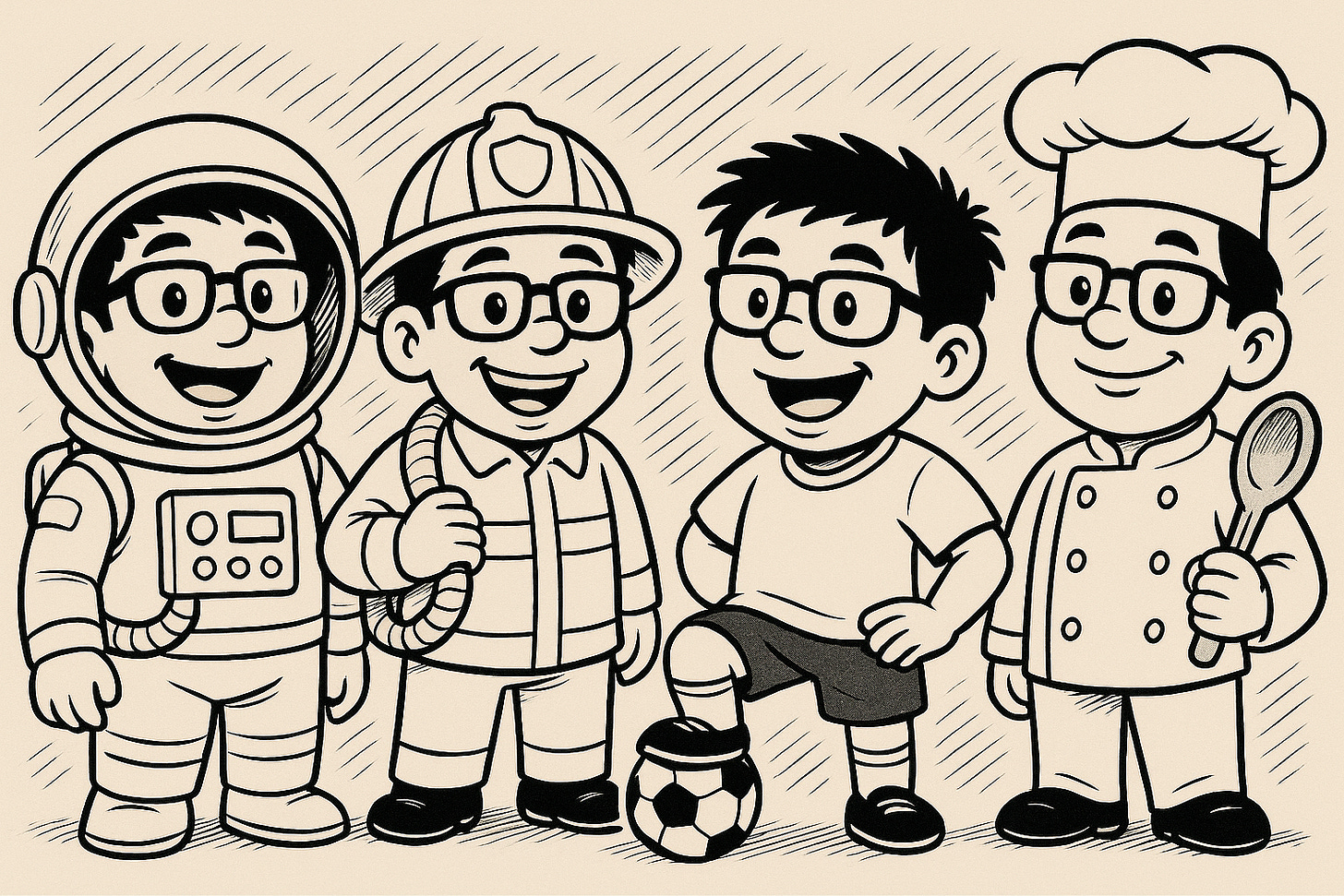Growing Into the Identity You Desire
Why self‑acceptance is the first step toward sustainable habits
When I started publishing my newsletter, I never saw myself as a writer. I wanted to be one, but deep down, I thought writers were a different breed. They woke up at dawn, churned out pages without fear, and spoke with unquestionable authority.
That wasn’t me.
If I had followed the popular advice to “act like the person you want to become,” I might have forced it. I could have copied Ryan Holiday’s routines or James Clear’s methods, tried to write in their voices, set ambitious word-count goals, and introduced myself as “a writer.” I would have been playing a role that didn’t fit. And when it didn’t work, I would have felt shame.
What worked was simpler: I started from who I actually was. I wrote daily notes and weekly posts in Substack. I shared struggles and small insights without pretending to have all the answers. Over time, my voice emerged and my rhythm developed.
“Writer” was not a costume; it was something I grew into.
Forget the Costume
Identity grows by practice, not performance.
We’re often told to decide the kind of person we want to be and then act like that person. The message can help, yet taken literally, it backfires.
You risk forcing habits that don’t fit your life. You might adopt routines built for someone else, with different constraints, motivations, and wiring. It feels artificial because it is.
Without self-acceptance, the identity buckles under expectation.
Research shows people persist longer and feel better when their goals are self-endorsed, aligned with their own values rather than imposed or borrowed12.
Identity-based motivation points the same way: when a context cues a “self” that fits the behavior, it brings ready-to-act scripts; when the fit is off, the same cues can undermine follow-through3. Habits repeated in a consistent context become easier to re-enter; value-aligned routines are more likely to integrate over time4.
While many think self-acceptance is complacency, in reality it supports change. Treating yourself with self-compassion after setbacks increases the motivation to improve, making “returning” more likely than doubling down on a fake persona5.
Yourself as the Starting Point
So what’s the alternative? Start by accepting who you are. Map your current strengths, routines, and constraints. Ask:
What energizes me, and what drains me?
When am I most productive?
Which habits already come naturally?
You can call it realism. In systems thinking, it means aligning strategies with the current state. You can’t sustain someone else’s system if it doesn’t fit your life. Begin by discovering how you work well now and build around that.
Here is why this matters: repeating a behavior in the same context increases its automaticity. When the behavior serves your values, it becomes easier to access and repeat. When it conflicts with who you are, it resists sticking.
Building a System That Fits You
I learned to spot the tools and anchors that keep me writing on a steady rhythm. Substack scheduling, notes, and transcription removed the night-before scramble. Once I understood how I work, I could build a path toward the identity I wanted: becoming a writer.
Your path will look different, and it should. A simple way to begin:
Set a true baseline. Pick a minimum you can meet on any day. Ten minutes of writing. One mile of walking. Small works when it is repeatable.
Use your high-energy window. Notice when you think most clearly and place your meaningful task there. Name the slot and protect it.
Upgrade in small moves. After the baseline holds, add one change that matches the identity you’re building. If you want to be a reader, read one page after breakfast and let it grow from there.
That pattern shows up in the lab. In 2019, at the University of Bath, psychologists Bas Verplanken and Jie Sui asked people to rate 80 everyday behaviors for how automatic they felt and how closely each fit the “true self.” On that first pass, the more a behavior felt like a habit, the more it felt like “me.” In a second pass, participants named the personal value each behavior would serve. That simple naming step strengthened the bond between habit and identity.6
The lesson is simple and clear: small, value-aligned actions hold.
Takeaways
It’s healthy to envision who you want to become. You reach it by accepting yourself and building a system that works for you now. From that foundation, identity change grows, one return at a time.
To evolve your identity rather than replace it, keep this in view:
Accept your starting point. Identity change begins with honesty. Name your strengths, your limits, and your context.
Design for your current self. Build routines that fit the life you have, not an idealized future.
Layer values-aligned habits. Attach small, meaningful actions to core values to tighten the link between doing and being.
Let identity accrue. With practice, routines feel less like costumes and more like second nature.
Once you reach this new identity, you will realize that, at the end of the day, it’s still you, that your identity is still the same; you will be just embracing better habits.
Never forget this:
Accept yourself before becoming somebody else.
Have a wonderful week!
Ready to Put This Into Practice?
If today’s insight helped you shift your mindset, the paid companion will help you live it.
Every Thursday inside the Disciplined Circle, you’ll get:
✅ 5 targeted prompts to turn reflection into behavior
✅ A gentle challenge to realign without overwhelm
✅ A weekly tracker to measure what matters
✅ Plus exclusive tools to build sustainable discipline
This is where insight becomes action — one step at a time.
Start your realignment practice today — $7.99/month or $79.99/year.
Cancel anytime.
✨ Ideas Worth Exploring
If this piece resonated, here are a few more that go hand-in-hand.
Enjoying this? Support the mission.
I write Self-Disciplined to help more people build real, lasting discipline — without burnout. If my work has helped you, consider supporting it with a coffee or becoming a member.
Sheldon, K. M., & Elliot, A. J. (1999). Goal striving, need satisfaction, and longitudinal well-being: The self-concordance model. Journal of Personality and Social Psychology, 76(3), 482–497. https://doi.org/10.1037/0022-3514.76.3.482
Ryan, R. M., & Deci, E. L. (2000). Self-determination theory and the facilitation of intrinsic motivation, social development, and well-being. American Psychologist, 55(1), 68–78. https://doi.org/10.1037/0003-066X.55.1.68
Oyserman, D. (2009). Identity-based motivation: Implications for action-readiness, procedural-readiness, and consumer behavior. Journal of Consumer Psychology, 19(3), 250–260. https://doi.org/10.1016/j.jcps.2009.05.008
Lally, P., van Jaarsveld, C. H. M., Potts, H. W. W., & Wardle, J. (2010). How are habits formed? Modelling habit formation in the real world. European Journal of Social Psychology, 40(6), 998–1009. https://doi.org/10.1002/ejsp.674
Breines, J. G., & Chen, S. (2012). Self-compassion increases self-improvement motivation. Personality and Social Psychology Bulletin, 38(9), 1133–1143. https://doi.org/10.1177/0146167212445599
Verplanken, B., & Sui, J. (2019). Habit and identity: Behavioral, cognitive, affective, and motivational facets of an integrated self. Frontiers in Psychology, 10, 1504. https://doi.org/10.3389/fpsyg.2019.01504








Your approach of starting from who we are rather than copying someone else’s habits really resonates. Thank you for this reminder to honor myself while growing
Very nice article with good info 👍🏻👌🏻💯